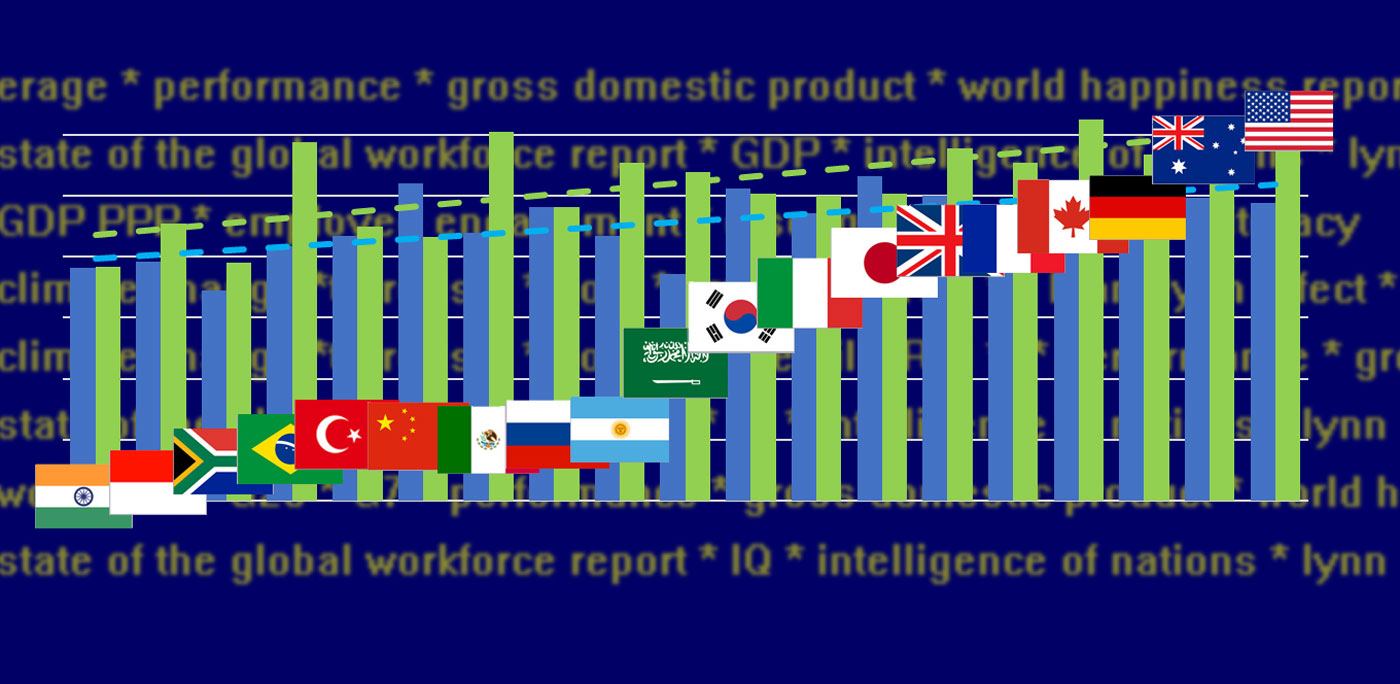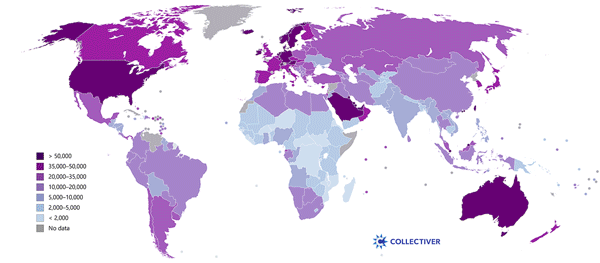Productivity, Happiness, Engagement and IQ

How Would You Like Your Team: Engaged, Happy or Smart?
According to the New York Times, 2019 was reportedly the best year ever for business performance. Climate change, terrorism and other global wrongs notwithstanding, 2019 was the first year on the books when stocks, bonds, gold and crude oil – all had double-digit returns.
Another notable achievement: we have approached 90 per cent adult literacy worldwide, with many countries in Africa and Asia showing exceptional gains in literacy, while recent studies reveal that the IQ of westerners has been declining.
Are these stats related?
What factors determine business performance worldwide, and how these factors are correlated?
I merged and analyzed the available data on GDP (per capita), national IQs, happiness, and employee engagement worldwide, for 93 countries. My goal is to come up with practical suggestions to business leaders; thus, these observations are focused more on qualitative results and trends than on the “scientificity” of the idea.
Here’s what I found.

Probably, the two have reciprocal causation, i.e. there is a positive feedback loop between national IQs and incomes that ensure the quality and quantity of education, leading to further growth of the national IQs.
Not surprisingly, GDP has a strong positive correlation with Happiness. Arguably, this is reciprocal as well because Happiness and Engagement are statistically correlated, and the level of employee Engagement determines business performance. Similarly, there is a strong negative correlation between Happiness and Active Disengagement.
On average, GDP is driven by the percentage of Not-Engaged (N/E) employees, while Actively Disengaged (DIS) and Engaged (EN) have a stronger impact in the weakest (let’s refer to them as Low-Value) and the strongest (High-Value) economies, respectively. You can find a short description of the engagement levels here.

In the High-Value economies (most G20 countries), this (GDP:N/E) correlation is insignificant, and the N/E percent is rather stable (see chart below). Their GDP numbers grow with ENG going up and DIS going down.
Likewise, GDP and Happiness show no significant correlation with IQ at the very top of High-Value economies (G7 and Australia). Although employees’ IQ positively correlates with GDP across the entire spectrum of economies, the IQ:HAP correlation is negative at the Low-End extremity (low-IQ nations tend to be relatively happier). Conversely, nations that have historically high IQ but lower GDP tend to be lower on Happiness and higher on Active Disengagement.

Applying Herzberg’s motivation-hygiene theory, Happiness may be considered a measure of “hygiene” factors, while Engagement reflects employee motivation. Happiness is a prerequisite for sustainable Engagement. As the global workforce continues to evolve, we may need to go beyond Herzberg’s notion of “satisfiers,” which sounded sufficient 60 years ago.
Projecting the above findings to an average company, here are some insights that may help business leaders improve their operational performance:
- Your business output is driven by the employees’ happiness, skills, and engagement level, but their impact will vary depending on the nature of your business.
- On average, business performance positively correlates with the employees’ subject-matter knowledge and skills, loosely measured by their IQ; this correlation is not linear.
- In a High-Value environment, IQ is high and stable. That could mean that employees’ subject-matter knowledge and skills are necessary but they are not the key driver of top performance. Engagement is a more probable factor of business efficiency.
- In Low-Value environment, high IQ may actually drive employee Happiness down, negatively affecting morale. Conversely, low-IQ people appear to be relatively happier. Thus, if you run a Low-Value business, your “best hire” is probably not the smartest – but rather the happiest one.
- Regardless of the nature of your business, you should look for happy employees and then make them Engaged and productive.
- Happiness and Engagement are strongly correlated. Employee Happiness is important for an average business, but its impact varies at the extremes.
- In a Low-Value environment, the business output correlates with Happiness but not so much with Engagement. That means, your performance improvement initiatives may be safely limited to maintaining the “hygiene” – market-level wages, basic safety, etc. – that will keep the employees “happy enough” to stay.
- When it comes to a High-Value business environment, its performance is determined more by employee Engagement, not just by Happiness. Your business performance will not improve significantly through monetary incentives (or free lunches, foosball, etc.), as today’s employees are organized by higher needs, and their value systems are different.
- Although Happiness is a prerequisite for Engagement, it is useless and outright impossible to boost employee happiness. The Hedonic Treadmill theory posits that, no matter what, humans will always return to the same baseline of happiness, regardless of what happens to them, good or bad.
If your vision is to take your business “from good to great,” you have to work on employee engagement. Monetary incentives and basic training or certification will not bring sustainable improvement. A culture transformation project is what you need.
Charts and images by Collectiver
First published on the People Development Network.
